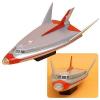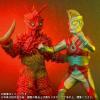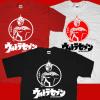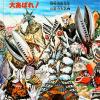|
ULTRAMAN COLLECTIBLES #01 |
Updated: January 10, 2024



































































































The Ultraman series used various monster costumes, known as kaiju in Japan, prior to other series such as Kamen Rider and Super
Sentai. The principals were played by famous monster suit actor Haruo Nakajima, who performed as the original Godzilla. Another
Toho actor, Satoshi "Bin" Furuya, was sought out for the role of Ultraman, because of his tall stature and perfect proportions. In
the image from episode 11, "The Ruffian from Outer Space" ( right ), we see an example confrontation, with Ultraman and the monster Gyango squaring off in a plaza in front of a hi-rise complex which will soon be trampled, and dwarfing the tree line.
Nakajima had an outdoor-sports and martial-arts background, and they decided that Ultraman would not seem alien if he was using
earth-bound martial arts techniques. So Ultraman's fighting style was a mixture of grappling, Greco-Roman wrestling, and some
Japanese martial arts, which evolved during the course of the series.
Often costumes of famous monsters like Godzilla ( as Jirass / Keyra in "The Mysterious Dinosaur Island" ) and Baragon would be
recycled and altered, sometimes with nothing more than spray paint and often while the actor was still inside. Nakajima quipped
once that the staggering gait of some of the monsters he portrayed was due less to his acting than to the fumes he had to endure.
Some of the quadrupedal monster costumes could not be shown fully as his legs dragging on the ground would have been exposed, a necessary allowance to maintain balance in the often cumbersome outfits. Also, the expense of repairing the scale cities and
landscapes used for battle scenes required economy of movement and meticulous planning.
Not all monsters resembled Godzilla or a dinosaur. Others included giant insects ( The Blue Stone of Vallarge ) or insect like creatures ( The Spaceship Rescue Command ); carnivorous plants ( The Secret of Miloganda ), mutated and giant humans or humanoids
( My Home is the Earth ), aliens, some with a very inhuman appearance ( Blast the Invaders ), a colorful aquatic monster looking
like a cross between a sea turtle and a narwhal ( The Undersea Science Center ), a yeti ( Phantom of the Snow Mountains ), and even
a mobile spherical bio-mechanoid creature from a higher dimension ( Passport to Infinity ).
|
 HOME
HOME
 About
About
 EMail Me
EMail Me TOP |
TOP |  PREVIOUS ITEM | NEXT ITEM
PREVIOUS ITEM | NEXT ITEM  ( 2 of 16 )
( 2 of 16 )



































































































